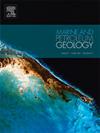Organic-walled dinoflagellate cyst record across the Campanian–Maastrichtian (Upper Cretaceous) boundary stratotype section (Tercis-les-Bains, SW France)
IF 3.7
2区 地球科学
Q1 GEOSCIENCES, MULTIDISCIPLINARY
引用次数: 0
Abstract
The Global Boundary Stratotype Section and Point (GSSP) for the base of the Maastrichtian Stage (Tercis-les-Bains, SW France) was formally approved in 2001, but over the years the boundary definition gave rise to serious doubts about the utility of some of the macro- and microfossil events chosen to approximate the position of the boundary. To address the issue, the Subcommission on Cretaceous Stratigraphy appointed a new Maastrichtian Working Group, whose members recently revisited Tercis section. Re-sampling of the GSSP locality revealed relatively rich and diverse dinoflagellate cyst assemblages. The stratigraphic succession of the highest (HOs) and lowest (LOs) occurrences of particular cyst taxa is compared with the dinoflagellate cyst record previously reported from the site and elsewhere. We noticed that among the dinoflagellate cyst events included in the definition of the Campanian–Maastrichtian boundary, only the HOs of Raetiaedinium evittigratia, and of R. truncigerum can be used as good boundary markers. Other formal cyst bioevents either had a restricted biogeographical distribution (Corradinisphaeridium horridum), or disappear distinctly above the Maastrichtian GSSP level (Samlandia carnarvonensis, S. mayi). The HOs of Coronifera oceanica, Gillinia hymenophora, Odontochitina costata, Xenascus ceratioides, and the LOs of Cladopyxidium paucireticulatum, C. saeptum, C. verrucosum, Glaphyrocysta expansa, and of G. pala, can probably also be used to approximate the Campanian–Maastrichtian transition. The actual utility of the above-mentioned bioevents seems promising, but requires further studies. First preliminary paleoenvironmental data were acquired based on the composition of the entire dinoflagellate cyst assemblage from Tercis.
求助全文
约1分钟内获得全文
求助全文
来源期刊

Marine and Petroleum Geology
地学-地球科学综合
CiteScore
8.80
自引率
14.30%
发文量
475
审稿时长
63 days
期刊介绍:
Marine and Petroleum Geology is the pre-eminent international forum for the exchange of multidisciplinary concepts, interpretations and techniques for all concerned with marine and petroleum geology in industry, government and academia. Rapid bimonthly publication allows early communications of papers or short communications to the geoscience community.
Marine and Petroleum Geology is essential reading for geologists, geophysicists and explorationists in industry, government and academia working in the following areas: marine geology; basin analysis and evaluation; organic geochemistry; reserve/resource estimation; seismic stratigraphy; thermal models of basic evolution; sedimentary geology; continental margins; geophysical interpretation; structural geology/tectonics; formation evaluation techniques; well logging.
 求助内容:
求助内容: 应助结果提醒方式:
应助结果提醒方式:


